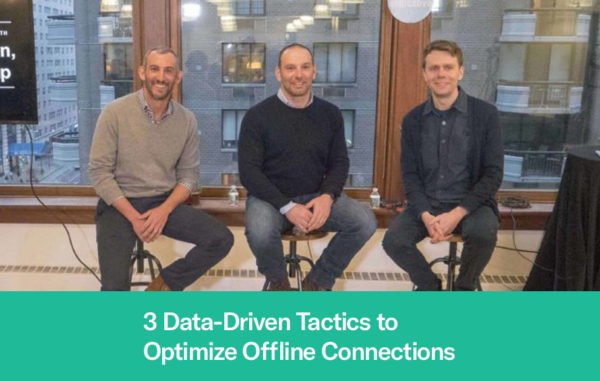Want to find out how data can drive your business into the future? Request a demo of Indicative today!
Meetup’s co-founder and CEO Scott Heiferman says he created the company in 2002 to “use the Internet to get people off of the Internet.” But even an offline community can be optimized with data-driven tactics.
At a live podcast recording at the UX + Data Meetup, Heiferman told Indicative co-founders Jeremy Levy and Andrew Weinreich about how Meetup plans to bring people together using new technology.
To hear more of our conversation, check out our podcast episode featuring Heiferman on Deciding by Data.
1. Sending push notifications to nudge you to meet someone new
Meetup is always seeking to “optimize for maximum positive impact,” Heiferman said. It’s not just about whether you showed up to an event, but whether you remember it fondly later on. Part of this is making sure Meetup attendees connect with one another. Heiferman suggested that one data-driven way to do this might be to send people messages on their phones encouraging them to meet someone else at their event who has a similar interest or background.
“We can actually buzz the people’s phones so that they say, ‘Hey, why don’t you meet this person because you went to the same school,’” Heiferman said.
2. Using Machine Learning to Start New Groups
Right now, if you wanted to start a new Meetup, you’d have to click a button, sign up, and pay to become an organizer. But Heiferman said Meetup is experimenting with the possibility of eliminating that process entirely by having machines create Meetups that members are clearly asking for.
For example, if 20,000 people said they wanted a running Meetup in New York City, Meetup will wait for someone in the area to start that Meetup, and then tell everyone who expressed interest about it.
“Basically, then,” Heiferman said, “when someone starts a running Meetup in New York City, it alerts all the people in New York City who are waiting for running Meetups that look, ‘Matt started a Men’s Staten Island Running Meetup for Sunday mornings at 6:00 am.’ And most of you, you are like, ‘I don’t live in Staten Island. I don’t want to run at 6:00 am. I don’t want a men’s-only running Meetup.’”
So instead of waiting for people to create the groups relevant to them, Heiferman asked, “Why can’t machines start that Meetup and then people can bring the caring and the creativity to it?”
3. Understanding the subtle workings of Meetups using data-driven insights
Meetup’s recent acquisition by WeWork opens a lot of doors for organizers hoping to plan events, as well as for Meetup’s ability to understand them. With WeWork providing the space for Meetup’s communities, Heiferman said, they will be able to ask data-driven questions like, “What does it mean to have 10 Meetups on one floor at the same time? Not just do people bumping into each other and say, ‘Hey, you’re with the French language Meetup’ and ‘Hey you’re with the feminist book club,’ or whatever, and they should collaborate … but it’s really about the feeling in the room, the frequencies.”
